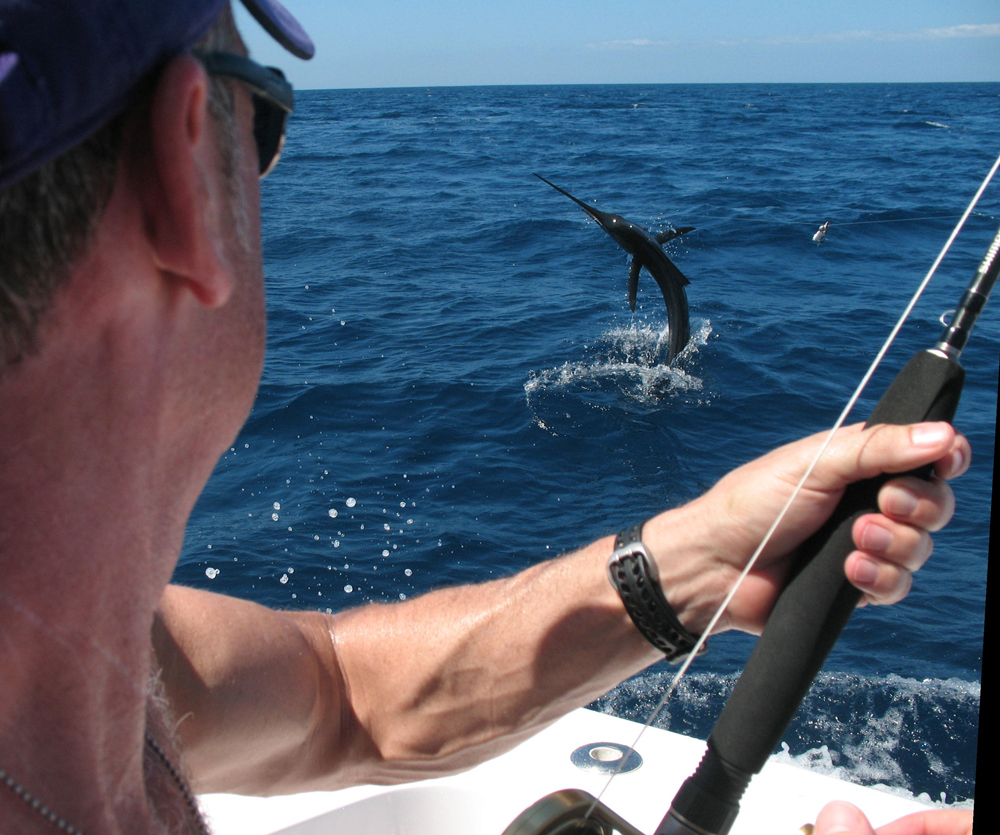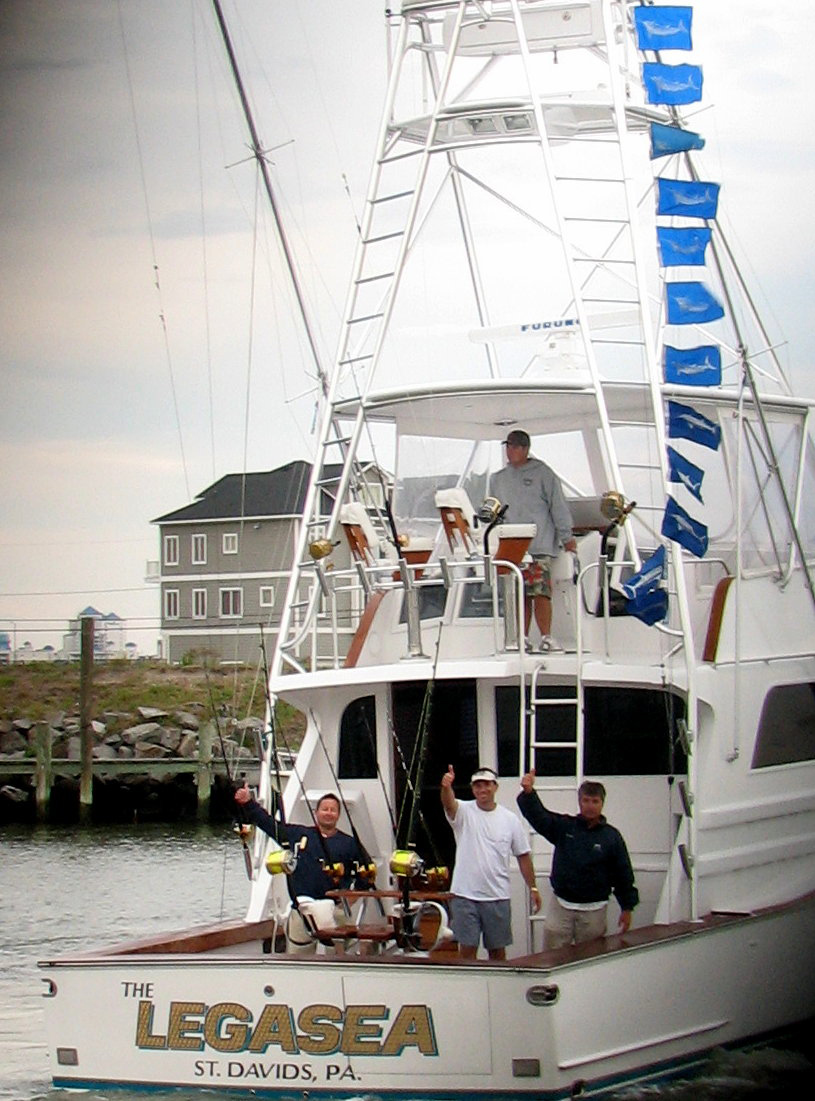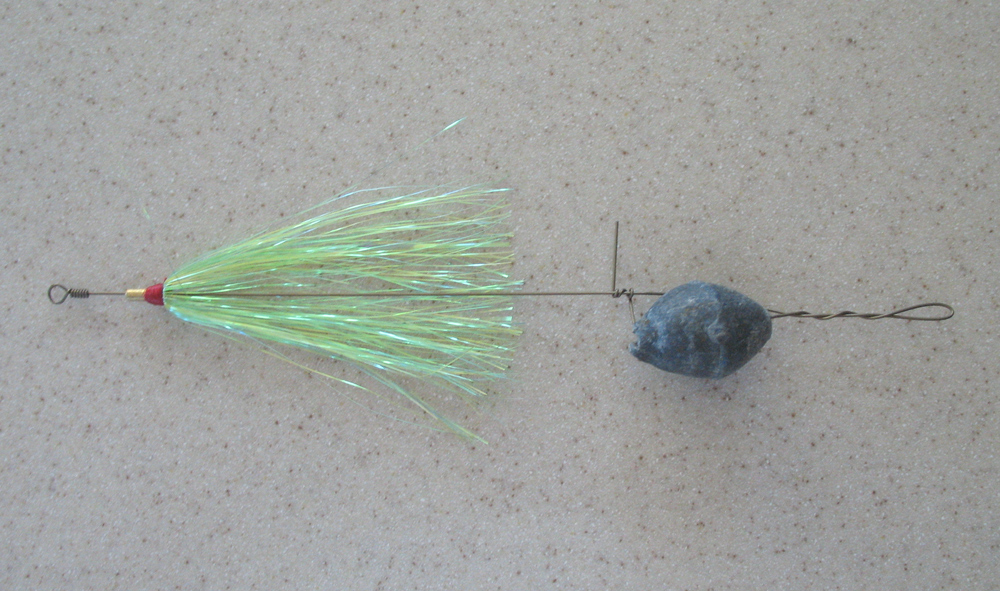Every offshore angler dreams of the moment they encounter a white marlin or a blue marlin, and we were all watching the our ballyhoo baits swim behind the boat when the shout came off the bridge: “Marlin, left teaser!” Everyone jumped into action and the lit-up billfish came on hot, as the teaser was wound towards the boat. The pitch rod was in my hand, being free spooled for the bait and switch, when suddenly “Marlin, right flat line!” came bellowing down from above. A second later the boat veered starboard towards the first blue as it felt the sting of the hook and performed a Houdini line-disappearing act, with greyhounding leaps – and a second blue exploded just behind the transom, creating a shower of spray when the other mate’s hook came tight. We passed the rods off to anglers as ecstatic shouts erupted, with two blues airborne simultaneously.

This may be more than most anglers could hope or ask for, but Captain Josh Ruskey is a serious billfisherman and his next shout from the bridge was for us to pay attention, before clearing rods.
Just then a third bill appeared behind the port bridge teaser.
This bait-and-switch was also text-book perfect, but with three billfish going ballistic in opposite directions, even for our experienced crew we had bitten off more than we could chew. The third billfish threw the hook, which was probably a blessing in disguise. All efforts were then concentrated on the two remaining blues, both of which were caught and released.
You want to increase your chances of experiencing billfish bedlam like this? Welcome to Part III of our FishTalk Offshore Trolling series, Billfish Tactics. (If you missed 'em, the first two installments included How to catch Tuna: Trolling, and Offshore Trolling: The Art of the Mixed Spread).
The Marlin Fishing Basics
Artificial lures certainly are responsible for their share of marlin caught, but trolled rigged baits are the number one method of connecting with billfish. However, there are no “absolutes” or “the only correct” type of spreads, baits, or ways to troll for billfish. There are so many methods of rigging bait and constructing leaders that the topic is better left for a separate article. Let’s just assume everyone is using circle hooks when billfishing – something the pros certainly do these days. Thirty class tackle with 80 to 100 pound wind-on leaders for whites, hatchets, spearfish, and sails, with 50 or 80 class outfits with 250 to 500 pound wind-ons for blues. Ballyhoo is the number one rigged bait, with mullet, mackerel and squid rounding out offerings.
Rigged bait must look natural and swim correctly regardless of the method rigged.
The question often arises, “How fast should I troll?” Do not regulate speed by the GPS or engine rpm. These can provide a starting point, but depending on water conditions, current, and wind, the best speed constantly changes. Watch the baits and troll at a speed so they appear to swim naturally. If heading into a two-knot current and the boat speed is 5.5 knots over the bottom, in reality the bait is swimming at 7.5 knots and is probably skipping on the surface. This is fine if that is your intended bait presentation. However, most rigged bait swim best between four and six knots.
Finding Marlin
Action like we described earlier is often attributed to luck, or being at the right place at the right time. While there is some truth to this thinking, more often than not successful anglers make their own luck. Spend a summer around a charter marina and you’ll observe the same charters constantly scoring for their clients. Success is achieved, as simple or stupid as it sounds, by specifically concentrating their efforts in the billfish’s bailiwick. Locating billfish is like constructing a puzzle, and focusing on putting all the pieces together to create opportunity.
VHF chatter often refers to “good looking” water. Anglers consider good water as clean, clear, and blue. Marlin also consider these conditions good water, but would add that temperature should be in the 70s and the number one contributing factor must be present: food. Without a food source billfish (and other species) are practically non-existent.
However, there is a problem when you focus on fishing in clean, clear water, only: it does not contain much plankton, which begins the food chain. So if you spend all your time trolling clean, clear water, even in the correct temperature range and area, chances of finding a good bite are slim.
Plankton is present in greener water, or when deep nutrient-rich water rises in an upwelling. As a result, an edge between green and blue water is one of the best areas to concentrate your efforts. Shorter transition distances normally result in better fishing. It should also come as no surprise that bait is often found around temperature breaks. A two- or three-degree break is all that’s necessary. Along the Atlantic seaboard, temperature breaks are found when warm clean Gulf Stream water pushes in from the east against green inshore water containing lots of plankton – the pieces of the puzzle start falling into place. Billfish do not travel in schools, but they do gather for feeding opportunities and stay in a given area as long as baitfish and the right conditions are present. So find blue water forming a wall against green water, throw in a temperature break, and in all probability baitfish can be found somewhere along this line with billfish in pursuit.

Since most anglers are not fortunate enough to fish every day and keep track of these variables, other options are required for obtaining information. There’s no better information source then making friends with a couple charter captains or mates at your local marina who are in the deep every day. If you’re serious about offshore fishing, a subscription to one of the satellite sea-surface temperature (SST) websites is another invaluable source of intel for locating temperature breaks and warm eddies of water. In addition to paid sites, free service such as those provided by Rutgers University’s Coastal Ocean Observation Lab provides current temperature information.
While satellites do not pick up actual pods of baitfish or weedlines, they do identify plankton in the form of chlorophyll. High levels indicate nutrient-rich water, while lower levels indicate clean blue water. Locate areas where these two clash, throw in a temperature break, and you’ve found the numbers to punch into the GPS to begin a day offshore. These edges often contain flotsam or weedlines which enhance fishing conditions.
The Billfish Trolling Spread
A five-line spread along with two pitch rods is typical for billfishing. This includes two flat lines, two short riggers, and a sweet spot. Also in the spread are four teasers and two dredges. If the outriggers can handle them the dredges are pulled off riggers, controlled with electric reels from the bridge, and positioned beneath the surface in clear water. Otherwise, they’re pulled off dredge rods with electric reels in the pit. On smaller fishing platforms dredges can be pulled from the corners of the transom. Two teasers are positioned outside and behind the dredges. They’re also controlled from the bridge with electric reels. Two more teasers are run a little further back, off teaser rods operated from the pit. Depending on the size of your offshore rig, this spread will need to be adjusted. However, always remember that dredges and teasers raise fish – period!
Anglers can add two more long rigger lines if a seven-line spread is desired, but most serious billfishermen drawn the fish into the spread and close to the boat for a bait-and-switch. At least one pitch rod (preferably two) is rigged and ready for task. If blues and whites are both present it may be prudent to have a 30 and a 50 prepared.
Choosing and Making Billfish Dredges
Regardless of the number of rods or teasers you decide to pull, invest in or build good dredges. A large dredge displaying a school of bait certainly draws attention, but do not discount any size dredge for raising fish. Strip teasers, rubber fish, or natural bait dredge all work. Holographic rubber fish look great and have raised a lot of fish off my transoms. An all-natural bait dredge or a dredge combining natural and rubber bait (with the natural bait displayed on the outside edge of dredge and the rubber on the inside) is at the top of the list. Most anglers do not like to spend a lot of time rigging ballyhoo or mullet for a natural dredge, but here’s a quick easy method for rigging a natural dredge. How quick? After the pin rigs are constructed, a 24 fish dredge can be rigged in less the 10 minutes.
Make up pin rigs with #12 or #15 wire. Use one- or two-ounce egg sinkers for ballyhoo or mullet. A skirt is not necessary, but does add flash and is used by most of the charter fleet. Insert the twisted end of the wire under the ballyhoo gill and down into its stomach, push the pin up through the mouth, and secure it with a rubber band. Then clip it onto dredge arm. It’s that easy. Be sure to prepare and salt down ballyhoo or mullet night before fishing, so they do not wash out.
Check out the Billfish Special Part II: Baiting and Hooking

For additional billfish tips and techniques check out author’s books, “Offshore Pursuit” and “Saltwater Tales.”
To see short How-To tip videos, including one on choosing and deploying dredges for billfish fishing, check out the Offshore Fishing Playlist on FishTalk's YouTube channel.
- By John Unkart